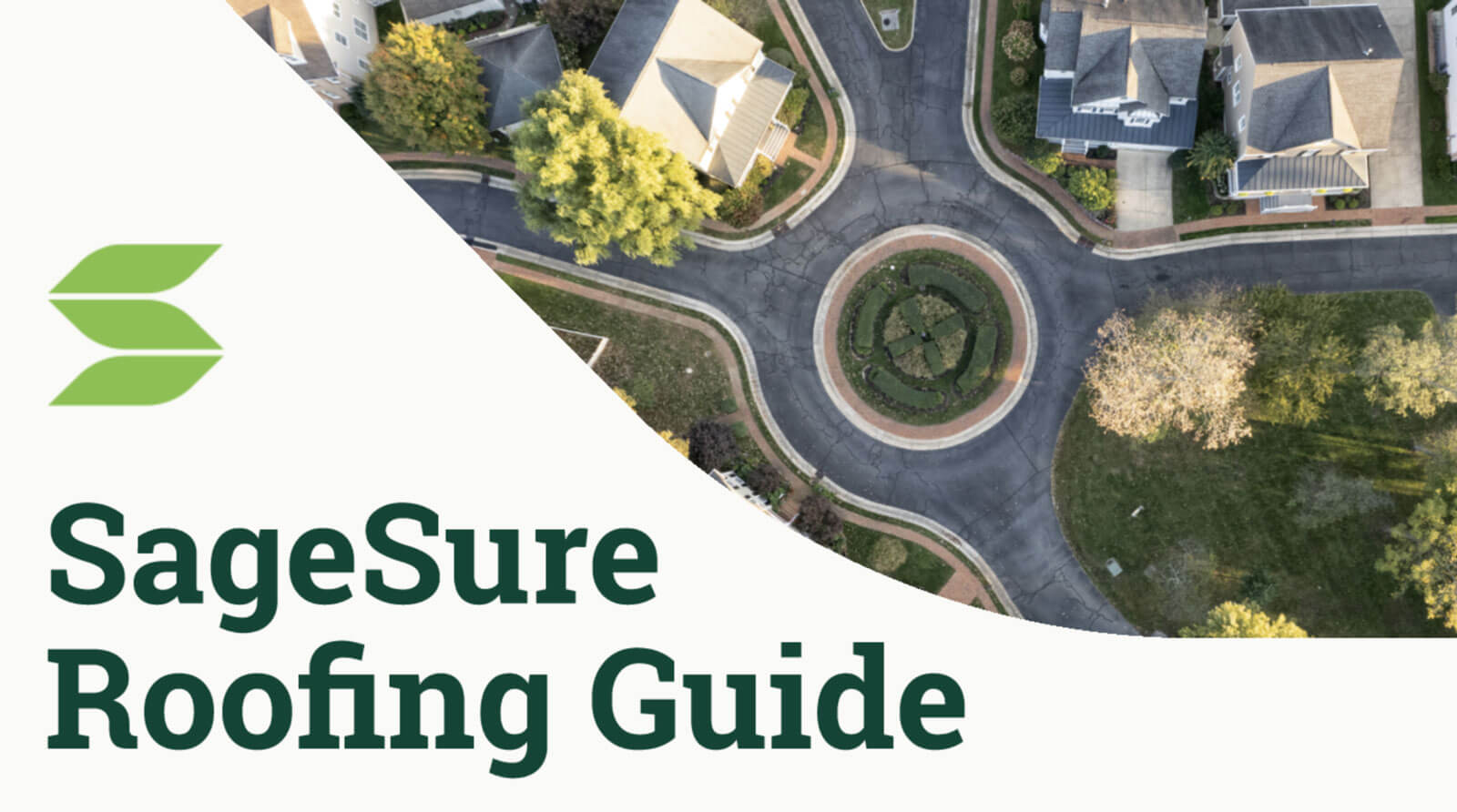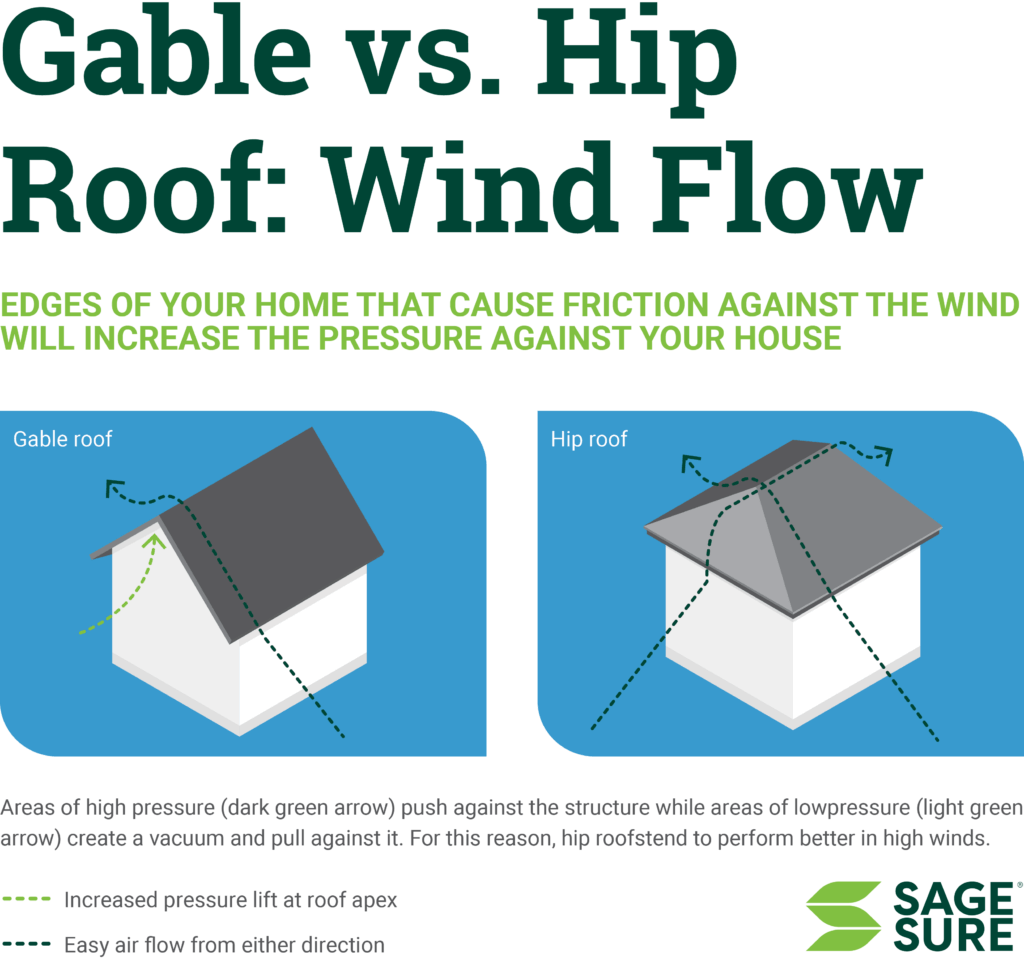
SageSure Roofing Guide
How to maintain your roof to protect your home
A roof is one of the most critical parts of your home. It provides structural integrity for your house, protects you from Mother Nature — sun, wind, rain and snow — and insulates against temperature changes. Roofs also add to the aesthetics of your home and contribute to curb appeal.
With all the functions a roof provides, keeping it in good repair and knowing when it’s time for a replacement is a big part of home maintenance. This guide will walk you through the various factors to consider when evaluating and replacing your roof.

How do I know if I need a new roof?
Some signs that your roof needs replacing are noticeable, while others require a trained eye to detect. Here are a few things to consider when assessing your roof.
Weather events
Roofs often need to be restored after damage from wind or hailstorms. If your area has experienced large-scale weather events recently, be sure to assess the damage to your roof. But take caution not to get caught by fraudulent, fly-by-night roofers looking to take advantage of unsuspecting homeowners after disasters.
Leaks
It may be obvious, but if you’re experiencing leaks, it’s a good indication that roof integrity is compromised. Multiple layers in your roof protect your home — deck paper/underlayment, flashing, ice and moisture barriers, shingles, vent stack boots and other components — all of which work together to create a waterproof barrier. Some or all these elements can fail as the roof ages.
“Keeping up with the Joneses”
If you live in an area with newer construction homes all built around the same time, when your neighbors are replacing their roofs, it’s a good idea to think about replacing yours. Even without visible wear or obvious damage, your roof might be at an age where investing in a new one outweighs the cost of possible damage when parts wear out.
Signs of wear
Shingles are only one part of your roof, but signs of visible wear on them can indicate they need replacing. When the granules on the shingles wear thin or create bald spots, they become less effective at reflecting heat, causing your home to warm faster. Additionally, the granules protect the asphalt from drying out. Without them, the asphalt can crack and leak. Lifting, curling or cracked shingles allow moisture to penetrate the roof deck, resulting in water damage to the structure and possible leaks inside your home.
If you still have questions about the integrity of your roof, hire a roofing contractor to perform an inspection. This is the best line of defense against costly damage that can be difficult for homeowners to detect when examining from the ground.

Things to consider when it’s time for a new roof
Perhaps you know someone who opted to add a second layer of shingles to their existing roof instead of a complete replacement. Universal building code allows for this, but here are some considerations before making this decision. If you have damage to the roof deck, like known leaks, soft spots or sagging, this must be repaired. In this instance, the existing layer of shingles needs to be removed to access the deck, so a second layer is not a feasible solution.
Another instance where having a second layer is not ideal is when flashing around chimneys and dormers needs to be replaced. To change these elements of the roof, the shingles must be removed, preventing a second layer from being added. Second layers are also not ideal over high-profile dimensional shingles, or when the roof structure cannot support the combined weight of the two layers. Shingles can weigh more than 300 pounds per square foot. Add heavy snow, and your roof could be compromised.
Your roof deck is just one element of your roof. If there is damage to the roof deck, it won’t matter if you have new shingles. Your roofing contractor should inspect the decking for soft spots and areas where the nails are pulling out, indicating rotting or broken decking. Inspections inside the attic for damaged or stained areas can also reveal leaks. If mold is present inside, it’s an indication of poor attic ventilation.
There are several different types of roof deck underlayment, but they all provide a final moisture barrier to protect your home. The underlayment, made of asphalt or synthetic material, is installed horizontally in overlapping sheets on top of your roof deck. Asphalt underlayment is made by saturating paper or fiberglass with asphalt. It is one of the older and more cost-effective types of underlayment. Synthetic underlayment is made from polymers. It’s lighter, tougher, more water-resistant and easier to install; however, it comes with a higher price tag. No matter which type is used, the installation is most important.
Other parts of your roof
Unless you’re in the home-building business, you probably don’t know much about roof construction. In addition to the shingles, roof decking and underlayment, your roof also has moisture and ice barrier and starter strip shingles. Moisture and ice barrier lines the valleys of the roof where the different sections come together. Water flows through the valleys and can more easily penetrate the shingles. Starter strip shingles line the eaves and provide another layer of protection against storms with wind and moisture.
Roof ventilation
Constructed to keep the elements out of your house, roofs also require ventilation to prevent moisture and heat from becoming trapped inside your home. Without airflow, moisture and heat buildup cause mold, rotting roof deck, curling shingles and brittle asphalt. Ridge vents, located at the gap in the peak of a roof work together with soffit vents, located under the eaves. Soffit vents allow fresh air to flow in and ridge vents provide a way for air to escape. Gable vents are effective when a home has two gables and vents can be installed on each side to create a cross breeze. Larger homes and those with hip roofs will need roof vents installed. These can be passive vents, turbine vents and fan vents to draw the heat and humidity out of the attic.
Roof covering options
Once the structural frame and waterproofing elements are in place, the roof covering is added. There are a variety of options, ranging in price and style, to select from to protect your home. No matter what covering you choose, lighter color options will provide a significant amount of energy efficiency as they will absorb less heat.
- 3-tab ($-$$) – 3-tab shingles are composed of waterproof asphalt and ceramic granules.
- Architectural ($-$$) – Also made of waterproof asphalt and ceramic granules, architectural shingles are coated with an additional asphalt layer.
- Metal ($$-$$$) – Steel and aluminum are the most common metal roofs. Roofs can also be made of stainless steel, copper and zinc alloys. Roofs made of metal can be applied in a variety of ways.
- Wood shingles ($$-$$$) – Available in shingles or shakes, wood roofs are typically composed of cedar, treated pine, redwood or cypress.
- Clay and cement tile ($$-$$$$) – Clay tiles are made from baking molded clay. Concrete roof tiles are made of a mixture of water, sand and cement.
- Built-up roofing (BUR) ($$-$$$) – BUR consist of layers of fabric and asphalt and is finished with a layer of stone or gravel.
- Slate ($$$$) – Slate roof tiles are a natural roofing product made of hard (metamorphic) rock.
- Rubber ($$$) – Rubber (also known as single-ply membrane) roofs can be installed in sheets or shingles, and are typically composed of recycled tires, slate dust and sawdust.
- Solar ($$$$-$$$$$) – Solar roofs can be composed of shingles (with solar cells) or panels. Both are made of silicon, the second most abundant element in the Earth’s crust.
For more information about roof covering options, click here.
Shingle manufacturers
More than 75% of homes are covered with 3-tab or architectural shingles. When it comes to selecting the right product for your home, there are some popular brands to choose from. GAF and CertainTeed are popular brands, along with Owens Corning, IKO, Tamko, Malarkey and Atlas. Your roofing contractor can help guide your decision. You can also learn more at the Insurance Institute for Business & Home Safety Guide to Impact-Resistant Shingle Performance Ratings.
Special considerations for hurricane-prone areas
If you live in the Gulf Coast or Eastern Seaboard regions, you are likely to experience greater intensity and frequency of storms. Hurricanes, tropical storms and related wind can all damage your home, especially your roof. If it’s time for a roof replacement and you live in these storm-prone areas, here are some things to consider.
- No matter what type of roof covering you choose, it must be installed precisely to the manufacturer’s specs. Improper installation can lead to significant roof damage, including blow-offs during dangerous wind events.
- Select a contractor who understands the importance of proper installation for high-wind resistance, especially with 3-tab shingles.
- Metal roofs tend to perform best when professionally installed, compared to other types of roof coverings.
New construction considerations in hurricane-prone areas
If you’re considering building a home in these areas, work with an architect to understand the aerodynamics of roof design and select an option, like a hip roof, to help mitigate the effects of storm damage. Reducing eaves and overhangs can eliminate areas for the wind to catch your roof. It’s also important to consider a wind-resistant roof covering that meets the American Society for Testing Materials (ASTM) D7158 or D3161 ratings.

What do I need to know about my roof warranty?
As with any home purchase you make, understanding the warranty on the roofing products you select will enable you to protect your investment — and your home. Roofing products typically have a standard manufacturer’s warranty for the product and an extended manufacturer’s warranty for continued product coverage and installation. Typically, for a warranty to apply, the owner needs to register the product to qualify. Some warranties can even be transferred between homeowners.
All warranties are different, but if you have 3-tab or architectural shingles, pay close attention to yours. These types of roof coverings have an adhesive tab that seals the shingles together. It’s activated by UV heat and can deteriorate over time. When the adhesive fails, shingles can curl, and water can penetrate and compromise your roof. Roofs less than 5 years old can show this type of wear. This product failure is sometimes covered under the manufacturer’s warranty but isn’t always obvious to a homeowner when viewing from the ground. Know your warranty and consider having your roof regularly inspected to identify the integrity of the products and detect any problems before they result in damage.
Read more about selecting and maintaining your roof
Read more about roof coverings
Read more about roof styles
Read more about questions you should ask before hiring a roofer
